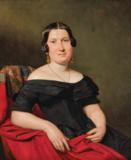Ferdinand Georg Waldmüller
}.webp', extensionName: 'dorotheum')})
(Vienna 1793–1865) Portrait of a Young Lady in a White Dress, signed and dated Waldmüller 1840, oil on panel, 32 x 26.5 cm, framed, (W)
Literature: Exhibition catalogue “Die Schöne Wienerin”, Galerie Neumann & Salzer, Vienna 1930, ill. 23. Rupert Feuchtmüller, Ferdinand Georg Waldmüller 1793–1865, Leben, Schriften, Werke, published by Christian Brandstätter, Vienna 1996, CR p.479,612. Provenance: Galerie Neumann & Salzer Vienna, Alois Hitschfeld, Vienna (purchased around 1930) Walter Hitschfeld, Vienna and Canada; Private Canadian collection (inherited). Ferdinand Georg Waldmüller Began his working life earning his income by painting miniatures, through which he also learned and perfected his skills of perception and detailed precision. (Cf.Bruno Grimschitz, Ferdinand Georg Waldmüller, Salzburg 1957, p.30). Portraiture accompanied Waldmüller throughout his life, and it is without doubt that his most famous works, in addition to his landscapes, are of this genre. It was his principle intention to depict the model as realistically as possible and to be accurate in evey detail (Sabine Grabner, Mehr als Biedermeier, Klassizismus, Romantik und Realismus in der Österreichische Galerie Belvedere, Vienna-Munich 2006, p.100). The subject of this portrait, an anonymous young woman, is shown full-face but with her body slightly turned away, against a neutral background. This slight turning of the upper body lends this representational portrait a playful touch, as does the scarcely perceptible smile and corkscrew curls of her hair which frame her face. The shawl has almost incidentally slipped, bearing her shoulders. The bow and red trimmings create a colourful contrast to the filmy white dress. The colour is repeated in the young woman’s cherry-red lips. The eyes are highlighted and appear most natural as she looks directly at the viewer. Light is reflected from her face and dress. Here Waldmüller demonstrates his special sensitivity for the different visual textures of skin, hair and clothing. The reflection of light and the shading of tones give the young woman a three-dimensional appearance. The combination of masterly detailed realism, striking liveliness and the perfect illusion of materiality are characteristic marks of Waldmüller‘s work. (Cf. Felbinger, in: Husslein-Arco, Grabner (pub.) , Ferdinand Georg Waldmüller, Vienna 2009, exhibition catalogue, p.69.) Grimschitz speaks of a “theme of calm sitting”, one which is lent an exceptional mutability in Waldmüller’s paintings, above all in the psychological expression. The more reserved the play of features - avoiding exaggeration of both the expression and physical appearance - the more lively and greater the active tension Waldmüller lends his subjects. The models sit for the painter with a natural unselfconsciousness, the subjectiveness of Waldmüller’s perception so completely denied that the figures portrayed appear to have a character entirely their own and their own active autonomy. (Bruno Grimschitz, Ferdinand Georg Waldmüller, Salzburg 1957, p.39, 42).
Specialist: Dr. Christl Wolf
 Dr. Christl Wolf
Dr. Christl Wolf
+43-1-515 60-377
19c.paintings@dorotheum.at
12.10.2010 - 18:00
- Realized price: **
-
EUR 31,955.-
- Estimate:
-
EUR 25,000.- to EUR 35,000.-
Ferdinand Georg Waldmüller
(Vienna 1793–1865) Portrait of a Young Lady in a White Dress, signed and dated Waldmüller 1840, oil on panel, 32 x 26.5 cm, framed, (W)
Literature: Exhibition catalogue “Die Schöne Wienerin”, Galerie Neumann & Salzer, Vienna 1930, ill. 23. Rupert Feuchtmüller, Ferdinand Georg Waldmüller 1793–1865, Leben, Schriften, Werke, published by Christian Brandstätter, Vienna 1996, CR p.479,612. Provenance: Galerie Neumann & Salzer Vienna, Alois Hitschfeld, Vienna (purchased around 1930) Walter Hitschfeld, Vienna and Canada; Private Canadian collection (inherited). Ferdinand Georg Waldmüller Began his working life earning his income by painting miniatures, through which he also learned and perfected his skills of perception and detailed precision. (Cf.Bruno Grimschitz, Ferdinand Georg Waldmüller, Salzburg 1957, p.30). Portraiture accompanied Waldmüller throughout his life, and it is without doubt that his most famous works, in addition to his landscapes, are of this genre. It was his principle intention to depict the model as realistically as possible and to be accurate in evey detail (Sabine Grabner, Mehr als Biedermeier, Klassizismus, Romantik und Realismus in der Österreichische Galerie Belvedere, Vienna-Munich 2006, p.100). The subject of this portrait, an anonymous young woman, is shown full-face but with her body slightly turned away, against a neutral background. This slight turning of the upper body lends this representational portrait a playful touch, as does the scarcely perceptible smile and corkscrew curls of her hair which frame her face. The shawl has almost incidentally slipped, bearing her shoulders. The bow and red trimmings create a colourful contrast to the filmy white dress. The colour is repeated in the young woman’s cherry-red lips. The eyes are highlighted and appear most natural as she looks directly at the viewer. Light is reflected from her face and dress. Here Waldmüller demonstrates his special sensitivity for the different visual textures of skin, hair and clothing. The reflection of light and the shading of tones give the young woman a three-dimensional appearance. The combination of masterly detailed realism, striking liveliness and the perfect illusion of materiality are characteristic marks of Waldmüller‘s work. (Cf. Felbinger, in: Husslein-Arco, Grabner (pub.) , Ferdinand Georg Waldmüller, Vienna 2009, exhibition catalogue, p.69.) Grimschitz speaks of a “theme of calm sitting”, one which is lent an exceptional mutability in Waldmüller’s paintings, above all in the psychological expression. The more reserved the play of features - avoiding exaggeration of both the expression and physical appearance - the more lively and greater the active tension Waldmüller lends his subjects. The models sit for the painter with a natural unselfconsciousness, the subjectiveness of Waldmüller’s perception so completely denied that the figures portrayed appear to have a character entirely their own and their own active autonomy. (Bruno Grimschitz, Ferdinand Georg Waldmüller, Salzburg 1957, p.39, 42).
Specialist: Dr. Christl Wolf
 Dr. Christl Wolf
Dr. Christl Wolf
+43-1-515 60-377
19c.paintings@dorotheum.at
|
Buyers hotline
Mon.-Fri.: 10.00am - 5.00pm
kundendienst@dorotheum.at +43 1 515 60 200 |
| Auction: | 19th Century Paintings |
| Auction type: | Saleroom auction |
| Date: | 12.10.2010 - 18:00 |
| Location: | Vienna | Palais Dorotheum |
| Exhibition: | 02.10. - 12.10.2010 |
** Purchase price incl. charges and taxes(Country of delivery: Austria)
It is not possible to turn in online buying orders anymore. The auction is in preparation or has been executed already.
More objects by this artist
-

Estimate:
EUR 35,000.- to EUR 45,000.- -

Estimate:
EUR 18,000.- to EUR 25,000.- -

Estimate:
EUR 12,000.- to EUR 18,000.-
